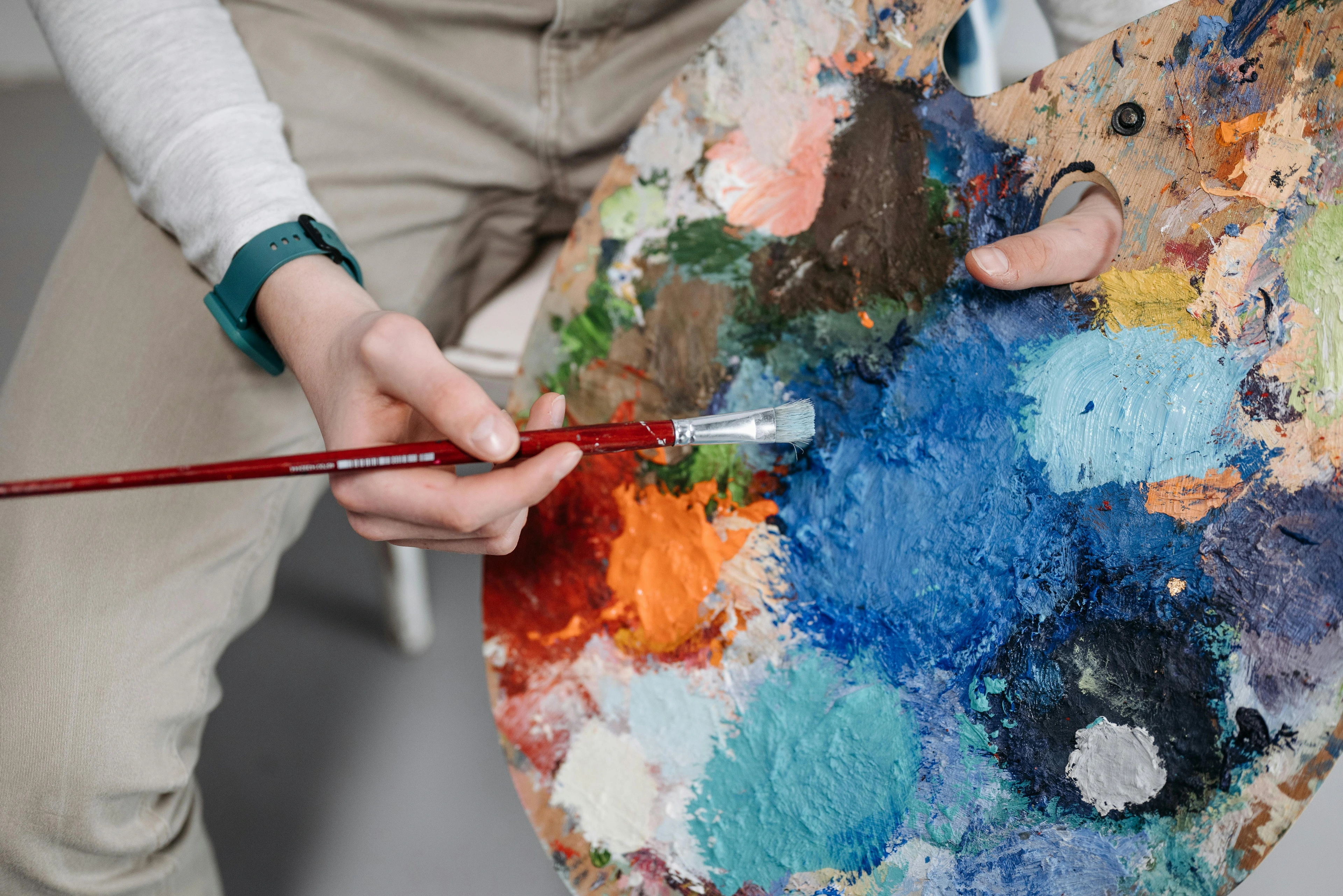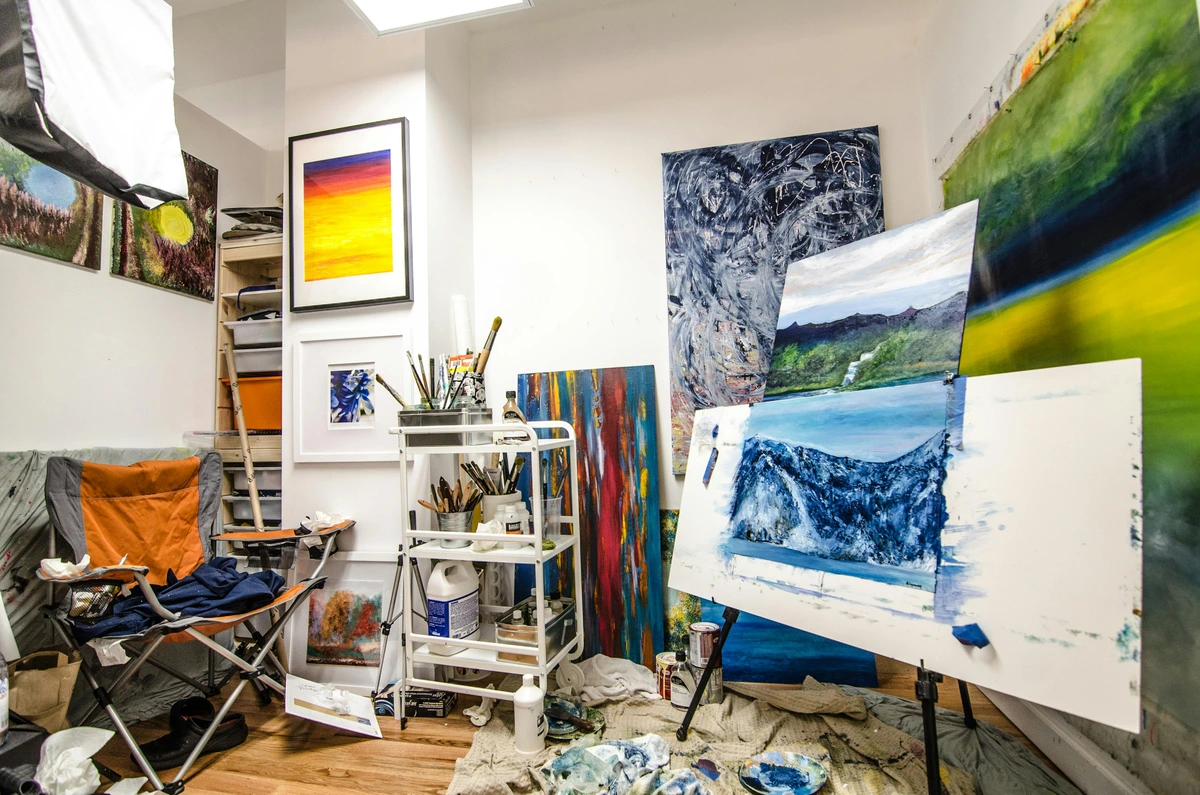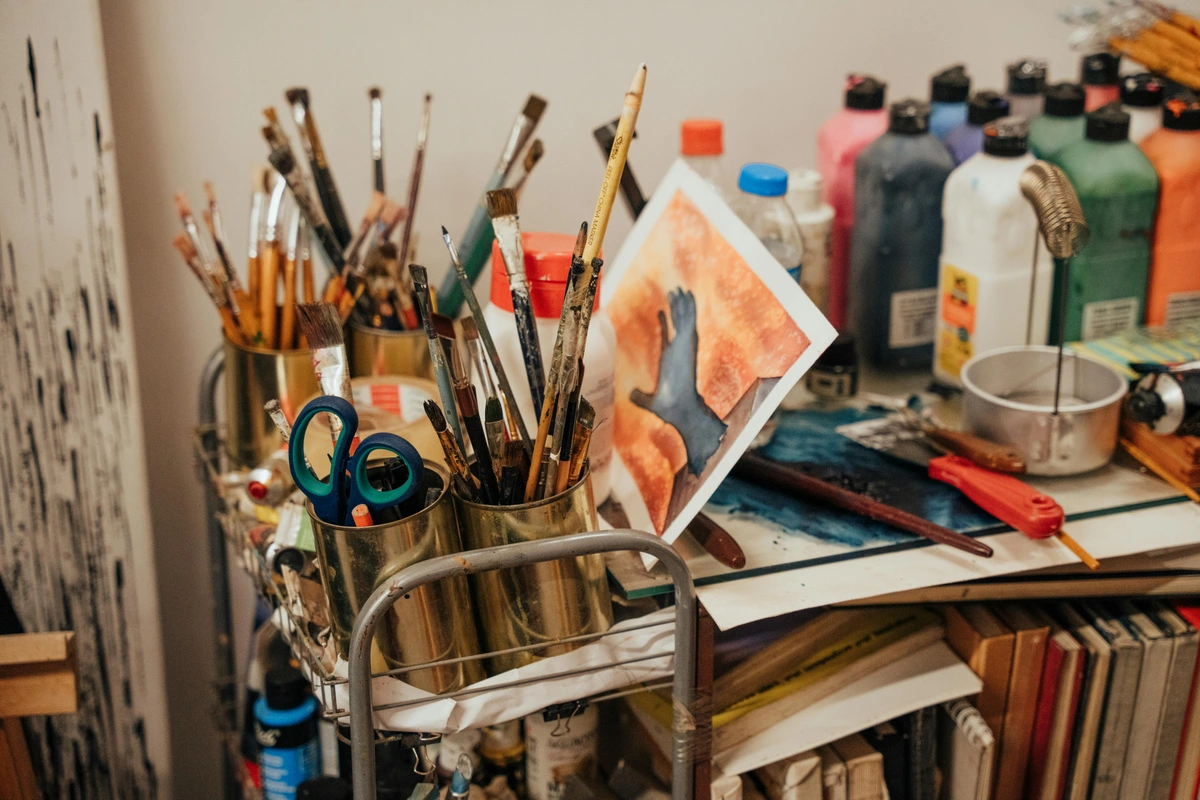
My Abstract Art Studio: Creative Chaos, Intuitive Process, Unfiltered Expression
Step inside my abstract art studio, a vibrant sanctuary where creative chaos fuels an intuitive artistic process and unfiltered self-expression. Explore my unique methods, essential tools, and profound philosophy behind each brushstroke.
My Abstract Art Studio: A Sanctuary of Creative Chaos and Unfiltered Expression
It's fascinating, isn't it, how a space can become an undeniable extension of your soul? For me, that space is my abstract art studio. It's far more than just four walls and a roof; it's a constantly evolving ecosystem of creation, frustration, triumph, and, if I'm being honest, the occasional glorious splash of cadmium red on my favourite socks. Beyond the tidy, finished piece you might admire, there's a world of vibrant energy, philosophical tangents that lead down unexpected paths, and relentless experimentation. Sometimes, these tangents involve pondering the very nature of perception – how a blob of paint on a canvas can evoke a feeling more potent than any literal depiction, perhaps by tying it to specific abstract art examples. For instance, a deep cerulean blue, applied with sweeping abandon, can evoke the vastness of the ocean's depths, not as a literal depiction, but as a felt sense of calm or mystery, a memory held in the psyche, rather than a scene observed. Similarly, the act of creation itself often mirrors the chaos and underlying order of the universe, where emergent patterns rise from apparent disarray.
If you've ever found yourself wondering what truly goes on behind the canvas—what thoughts simmer, what struggles erupt, and what breakthroughs ignite—this is your personal invitation into my world. Prepare for paint splatters, philosophical tangents that might make you tilt your head (like, is a perfect circle truly abstract if it represents perfection, or does its very ideal form transcend representation?), and perhaps a bit too much honesty about my perpetually 'evolving' organizational skills – let's just say my paint tubes often form their own rebellious, colorful mountains. What you'll find is a space that allows for true, uninhibited self-expression, a place where art isn't just made, but deeply felt into existence, a space where the very process of creation is as important as the final outcome.
The Soul of My Studio: Beyond the Walls and Expectations
When I say 'studio,' you might instinctively picture a pristine, minimalist space, flooded with natural light, every brush perfectly aligned. Well, let me share a more vibrant reality, one generously seasoned with the smell of linseed oil and the quiet hum of creative energy. My studio is, shall we say, 'lived-in' – and then some. It's where the magic happens, yes, but also where the nagging doubts sometimes fester, where ambitious experiments fail spectacularly (leaving behind abstract ghosts on forgotten canvases), and where my dog, bless his chaotic heart, occasionally attempts to 'help' by adding a new, furry texture. He's less of an assistant and more of a furry, four-legged art critic with a penchant for chewing brushes. Those "abstract ghosts" are often faint washes of color peeking through new layers, spectral outlines of scrapped ideas, or the subtle texture left by a brushstroke that was painted over – a visible record of the journey.
It's a place where I can truly be myself, utterly uninhibited by external expectations. There's no judgment here, just the ongoing, vibrant conversation between me, the canvas, and the defiant colours. This space has witnessed countless battles with artist's block, late-night epiphanies that feel like whispered secrets, and the sheer, exhilarating joy of a breakthrough. It's my refuge, my laboratory, and, on particularly challenging days, I suspect, my padded cell. One time, I spent hours trying to make a cerulean blue gradient work, only to rage-paint over it in fiery orange. The next morning, that orange canvas, now partially scraped back to reveal ghost-like blue undertones, became the foundation for one of my most dynamic pieces. It taught me that failure isn't the end, but often a necessary, messy detour – a lesson I now carry into every new series. Another time, I tried painting with my non-dominant hand for a week, resulting in a series of spectacularly wonky lines, but it unexpectedly loosened my style in ways I hadn't imagined.
To combat the inevitable creative lulls or moments of self-doubt, my studio also functions as a structured sanctuary, a set of personal rituals that ground me. There's:
- a specific "thinking chair" where I untangle creative knots, allow subconscious ideas to surface, or simply sit in profound, productive quiet, listening for the painting to speak;
- a dedicated corner for "failure canvases" that paradoxically often spark new ideas—like the time a muddy brown experiment, intended for discard, revealed an unexpected, rich undertone that became the basis for a vibrant new series; and
- a well-worn playlist that sets the creative mood.
These rituals, alongside the sheer permission to make a glorious mess, are my antidote to creative burnout, transforming potential frustration into renewed inspiration.

The Alchemist's Lab: My Tools, Materials, and the Dance of Light
Step into the heart of my creative arsenal, and you're immediately hit with the symphony of creation – the subtle scent of paint, the organized chaos of materials, the quiet hum of possibility. One of the first things you'd likely notice is the sheer volume of 'stuff,' a glorious testament to countless experiments and discoveries. Brushes of every conceivable size and stiffness, tubes of paint resembling a technicolor rainbow (a testament to my relentless pursuit of the perfect hue), an army of palette knives (my trusty companions for creating incredible texture), and more jars than I care to count – each holding some concoction, solvent, or just plain murky water. My workspace isn't a pristine museum display; it's a robust workbench, unapologetically stained with the vibrant history of countless creations. The scent of paint and canvas often lingers, a subtle perfume of ongoing work, creating an almost palpable atmosphere of ceaseless artistic endeavor.
Each tool, in its own way, tells a story. The worn bristles of a favorite brush, softened over years of dedicated service; the paint-caked handle of a beloved palette knife, perfectly molded to my grip – they're not just implements; they're vital partners in my ongoing artistic journey. I'm particularly fond of acrylics for their incredible versatility and, crucially, their quick drying time. This fast-drying nature is absolutely essential for my signature layering process, allowing me to build depth and complexity quickly, fostering an immediate, dynamic interplay between layers without the frustrating wait times of oils.
Here’s a quick overview of how different paint types fit into my world:
Paint Type | Pros for My Process | Cons for My Process |
|---|---|---|
| Acrylics | Fast-drying, versatile, great for layering, vibrant, adaptable. | None significant, they are my primary medium. |
| Oils | Longer blending times, rich depth. | Slow drying requires significant wait between layers. |
| Watercolors | Delicate, transparent washes. | Limited for my energetic, textural approach. |
Compared to oils, which offer longer blending times but require significant drying periods between layers, or watercolors, which are delicate and best for transparent washes, acrylics strike a perfect balance for my energetic and iterative approach to abstract art. They offer the richness of oils when applied thickly and the fluidity of watercolors when thinned, making them incredibly adaptable. Beyond the paints themselves, my studio is brimming with various mediums – gloss, matte, pouring – that manipulate consistency and finish. I often use pouring mediums to create fluid, organic forms and intriguing cellular structures, adding an unpredictable, almost liquid dimension to my otherwise textured works. Various varnishes protect and unify the final piece. Sometimes, even unexpected found objects find their way onto a canvas, adding a unique, unplanned dimension. These might be anything from discarded metal shards for raw texture, to fragments of fabric that hint at forgotten narratives, or even bits of broken electronics that speak to our modern, fragmented world. For instance, I once incorporated a broken circuit board into a piece about communication breakdown; its sharp angles and intricate lines added a surprising, almost brutal, counterpoint to the softer paint strokes, transforming the abstract forms into a commentary on technology's role in our lives. Another time, I incorporated a delicate, dried leaf into a piece about transience, its fragile veins contrasting with the bold acrylic strokes, adding an organic whisper to the abstract narrative. While not my primary focus, I've also experimented with inks for fluid lines and pastels for soft blending, recognizing their unique contributions to an artist's expressive toolkit.

And speaking of layers, the type of canvas matters immensely – it's the foundation of everything. If you're curious about how I navigate the myriad choices, you can read my in-depth thoughts on choosing the right canvas. When it comes to color, my studio truly comes alive. It's where I experiment fearlessly, blend intuitively, and often, make delightful 'mistakes' that lead to entirely new, unforeseen discoveries. My approach to the emotional palette is deeply personal, almost a conversation with my own subconscious, and seeing all those vibrant pigments laid out before me is like looking at a kaleidoscope of endless possibilities, each begging to tell a story.
Crucially, natural light is an indispensable, silent partner in my studio. It dances across the canvases, revealing the true nuances of color and texture that artificial light might obscure. The quality of light shifts throughout the day, offering new perspectives on a piece, almost like a subtle invitation to see it anew.

The Unfolding Canvas: My Creative Process and Abstract Philosophy
Moving from the tangible tools to the intangible dance of ideas, my process in the studio is anything but linear; it's more of an unpredictable, rhythmic dance between intuition and intent. Some days, I walk in, and an idea just explodes onto the canvas, demanding immediate expression. Other days, I stare blankly, plagued by the terrifying thought that I’ll never paint again (spoiler: I always do).
I typically start with broad, sweeping strokes, often just laying down fields of color to establish an initial mood or energetic vibration. These aren't just random marks; they are visceral responses, a channeling of initial emotions or a subconscious vision, sometimes even a nascent compositional idea, a way to quickly cover the canvas and break through the intimidating blankness. Then comes the layering – the iterative process of building depth and complexity, which is a truly fascinating part of my abstract acrylics process. This is where the true dialogue with the canvas begins. I add, I subtract, I obscure, I reveal. There are moments of intense, almost meditative focus, where hours melt away into what feels like minutes, and then moments of stepping back, just observing, letting the painting speak to me. This 'iterative process' isn't just about adding paint; it's a continuous cycle of creation, reflection, and adjustment, where each layer informs the next.
It’s during these reflective pauses that I often realize what the piece needs, not necessarily what I intended to be when I first picked up the brush. This surrender to the unexpected, this journey into the unknown, is the very essence of why I paint abstract – it's a profound conversation with the subconscious, a continuous journey of discovery where the destination is often unveiled only in the final brushstrokes. For instance, in one recent piece, I started with a predominant crimson red, aiming for raw energy. But as layers built, a soft, almost melancholic cerulean kept emerging from beneath, whispering of a different narrative. Instead of fighting it, I leaned in, allowing the red to become an explosive backdrop to the serene blue, creating a tension that utterly transformed the emotional impact of the work, making it both vibrant and introspective. That piece now hangs in a collector's home, a testament to embracing the unexpected.
Why Abstract? My Philosophy of Formless Expression
My journey into abstract art isn't just a choice of style; it's a philosophical stance, a personal quest for pure expression. For me, abstract art is the purest language of emotion and energy. It bypasses the literal and speaks directly to the soul, allowing me to express concepts, feelings, and experiences that defy easy representation. It’s not about depicting a landscape or a person, but about capturing the feeling of a stormy sky, the energy of a bustling city, or the fragility of a quiet moment. This non-representational quality makes it universally relatable; it taps into primal human emotions and experiences that transcend specific cultural or visual references, inviting each viewer to find their own meaning. For example, while one person might see a chaotic urban landscape in a piece, another might feel the exhilarating freedom of a dream, both valid interpretations stemming from the raw emotion the colors and forms evoke. It's a journey into the non-representational, a quest to find meaning and connection not in what is seen, but in what is felt.
This freedom resonates deeply with the pioneers of abstraction. Think of Wassily Kandinsky, who sought to express inner spiritual necessity through form and color, seeing art as a conduit for the unseen. Or Kazimir Malevich, who aimed for pure feeling in his Suprematist compositions, stripping away all objective representation. While early abstraction often had spiritual or utopian aims, later movements like Abstract Expressionism gave artists like Jackson Pollock and Mark Rothko the canvas to explore raw emotion, the subconscious, and personal psychology, shifting the focus to the internal world of the artist. My work, while distinctly my own, draws from this rich legacy, exploring the expressive potential of pure abstraction to create visual poetry that feels deeply personal yet universally resonant, a constant dialogue between my inner world and the external canvas.

Beyond the Brushstroke: Fueling Inspiration and Embracing Growth
Beyond the direct act of painting, my studio is a nurturing ecosystem for inspiration and growth. It's where I immerse myself in art books, devour podcasts on creativity and philosophy, and sometimes, I just sit in profound, productive quiet contemplation. For instance, I recently devoured a podcast series on neuroaesthetics, exploring how the brain perceives art, and it profoundly influenced my approach to form and flow. It's a space that consistently fuels my artist's muse, allowing me to absorb, reflect, and then translate those rich internal dialogues into a vibrant visual language.
I recently delved deep into the works of Hilma af Klint, whose pioneering abstract spiritualism deeply resonated with my own explorations of unseen forces and emotions in art. Her commitment to abstract forms as a means of expressing spiritual concepts, particularly her early, grand series created years before Kandinsky, profoundly challenged my own perception of art's purpose. It reinforced my belief that art can be a direct conduit to deeper, non-physical realities, a visual language for the inexpressible, pushing me to explore even more ethereal and energetic aspects in my own art. Or sometimes, it's a simple, seemingly mundane podcast about forest sounds that sparks an unexpected color combination, reminding me that inspiration truly is everywhere.
Navigating the Inevitable Bumps: Challenges and Growth
It's also, crucially, a safe space for failure. And let me tell you, there are plenty of 'failures' that pile up in a forgotten corner – canvases that just didn't quite make it, ideas that looked brilliant in my head but dissolved into muddy despair on the surface. A 'failure' for me isn't just a technical misstep; it's when a piece loses its emotional pulse, when the dialogue between me and the canvas ceases to resonate, or when it simply feels inauthentic to my evolving vision. These "abstract ghosts" – faint color traces, spectral undertones, or abandoned concepts peeking through new layers – are not mistakes, but echoes of previous explorations. They are often unexpected foundations or inspirations for future pieces, a visible record of my journey, a reminder that the path to a breakthrough is rarely linear. Once, after a particularly draining week where nothing felt right, I almost scraped a large canvas clean. But I stepped away, and the next morning, those faint, ghostly traces of my struggle sparked an entirely new direction, revealing a subtle texture I hadn't seen. It became a piece about resilience. This raw vulnerability is all part of the unpredictable, messy journey, much like the broader timeline of my artistic life. Creative burnout, the occasional self-doubt that whispers "you're not good enough," are all faced and processed within these walls, proving that true growth often emerges from vulnerability.
The Studio: A Reflection of My Art
My abstract art studio is more than just a place where paint meets canvas; it's a living, breathing entity that mirrors my artistic journey. It's where creative chaos gives way to form, where intuition dances with intention, and where every splatter and brushstroke contributes to a larger narrative of uninhibited self-expression. It’s a testament to the fact that true creativity isn't always neat or predictable, but it's always authentic.
I find myself often returning to the peace of my studio, a place where the outside world fades and only the conversation between artist and art remains. It’s here, amidst the glorious mess, that the silent dialogues of color, texture, and form coalesce into something tangible, something that speaks from my soul to yours. It’s a sanctuary not just for making art, but for being an artist. The spirit of this studio – its creative chaos, its philosophical depths, its uninhibited expression – isn't confined to these four walls. You can even visit my virtual museum in ‘s-Hertogenbosch, NL to experience how this dynamic energy translates into a curated space, offering a glimpse into the heart of my artistic world.
What does your creative space mean to you, and how does it shape your own journey of self-discovery?




